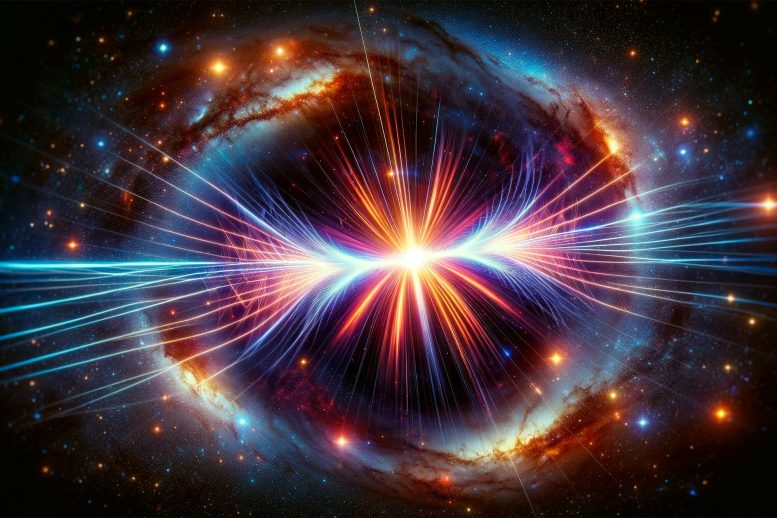
Scientists at the SETI Institute have advanced the understanding of Fast Radio Bursts (FRBs) through detailed observation of FRB 20220912A with the Allen Telescope Array. Their research, uncovering new properties and behaviors of these cosmic signals, highlights the ATA’s unique role in FRB studies and contributes significantly to the field of astrophysics.
This research demonstrates that innovative telescopes with unique capabilities, such as the ATA, offer fresh perspectives on unresolved enigmas in the field of FRB science.
Scientists from the SETI Institute have revealed new findings about the enigmatic cosmic phenomenon of Fast Radio Bursts (FRBs). Their study, focusing on the repeating FRB 20220912A, was conducted using the upgraded Allen Telescope Array (ATA) at the SETI Institute. This research provides a further understanding of these mysterious signals from space.
FRBs are brief, intense flashes of radio waves from deep space. While most happen only once, some “repeaters” send out signals more than once, adding to the intrigue of understanding their origin. Over 541 hours of observation, researchers detected 35 FRBs from repeater FRB 20220912A. The observations, made using the ATA, covered a wide radio frequency range and revealed fascinating patterns. All 35 FRBs were found in the lower part of the frequency spectrum, each with its unique energy signature.
Insights from the SETI Institute
“This work is exciting because it provides both confirmation of known FRB properties and the discovery of some new ones,” said the SETI Institute’s Dr. Sofia Sheikh, NSF MPS-Ascend Postdoctoral Fellow and lead author. “We’re narrowing down the source of FRBs, for example, to extreme objects such as magnetars, but no existing model can explain all of the properties that have been observed so far. It has been wonderful to be part of the first FRB study done with the ATA — this work proves that new telescopes with unique capabilities, like the ATA, can provide a new angle on outstanding mysteries in FRB science.”
Dynamic spectra (or “waterfall” plots) for all the bursts from FRB 20220912A detected using the Allen Telescope Array, the frequency-averaged pulse profiles, and the time-averaged spectra. The red-shaded regions in the time series plots denote the time span of the defined sub-bursts, with red vertical lines demarcating adjacent sub-burst. Credit: SETI Institute
The detailed findings, recently published in the journal Monthly Notices of the Royal Astronomical Society (MNRAS), showcase the intriguing behaviors of FRBs. These mysterious signals exhibit downward frequency drifting, a connection between their bandwidth and center frequency, and changes in burst duration over time. The team also observed something that had never been reported before: there was a noticeable drop in the center frequency of bursts over the two months of observation, revealing an unexpected cosmic slide-whistle.
In addition, the researchers used these observations to predict a cut-off point for FRB 20220912A’s brightest bursts, indicating its contribution to the overall cosmic signal rate. In fact, this specific object was responsible for a few percent of all strong FRBs in the sky during these observations.
The study also investigated the time patterns of the burst sequences, looking for repetition within and between the FRBs. No clear pattern was found, highlighting the unpredictability of these celestial phenomena.
The Role of the ATA in FRB Research
This work demonstrates the ATA’s important role in decoding the mysteries of FRBs. The ATA has the unique ability to record huge numbers of frequency channels at the same time, even if they’re widely-separated — for example, where some frequencies are very high and others very low. This allows for instantaneous checks when an FRB comes in, to constrain what the FRB is doing at high and low frequencies simultaneously. Ongoing upgrades promise even more capabilities, to see fainter FRBs at even more frequencies simultaneously, ensuring the ATA remains at the forefront of advancing our understanding of FRBs.
Two FRB 20220912A dataset parameters — center frequency and bandwidth — plotted over time, in MJD, from the beginning of the campaign to the end of the campaign (a time period of approximately 60 days). Panel a) indicates that the central frequency of the FRB decreases through the campaign (with residuals from the fit and a LOWESS non-parametric guideline shown below in blue). Panel b) shows the same decrease over time for bandwidth. Credit: SETI Institute
“It is exciting to see the ATA engaged in FRB research three years after its refurbishment started,” said Dr. Wael Farah, SETI Institute research scientist and co-author. “The ATA boasts unique capabilities that are being put at use in many research endeavors including fast transients.”
This milestone discovery marks a significant step forward in the ongoing quest to unravel the secrets of extreme objects in the universe. As scientists continue to explore the cosmos, each unique feature that we discover brings us closer to understanding the origins and nature of these captivating cosmic signals.
Reference: “Characterization of the repeating FRB 20220912A with the Allen Telescope Array” by Sofia Z Sheikh, Wael Farah, Alexander W Pollak, Andrew P V Siemion, Mohammed A Chamma, Luigi F Cruz, Roy H Davis, David R DeBoer, Vishal Gajjar, Phil Karn, Jamar Kittling, Wenbin Lu, Mark Masters, Pranav Premnath, Sarah Schoultz, Carol Shumaker, Gurmehar Singh and Michael Snodgrass, 03 January 2024, Monthly Notices of the Royal Astronomical Society.
DOI: 10.1093/mnras/stad3630
>>> Read full article>>>
Copyright for syndicated content belongs to the linked Source : SciTechDaily – https://scitechdaily.com/cosmic-whispers-unveiled-scientists-unlock-new-secrets-of-mysterious-fast-radio-bursts/